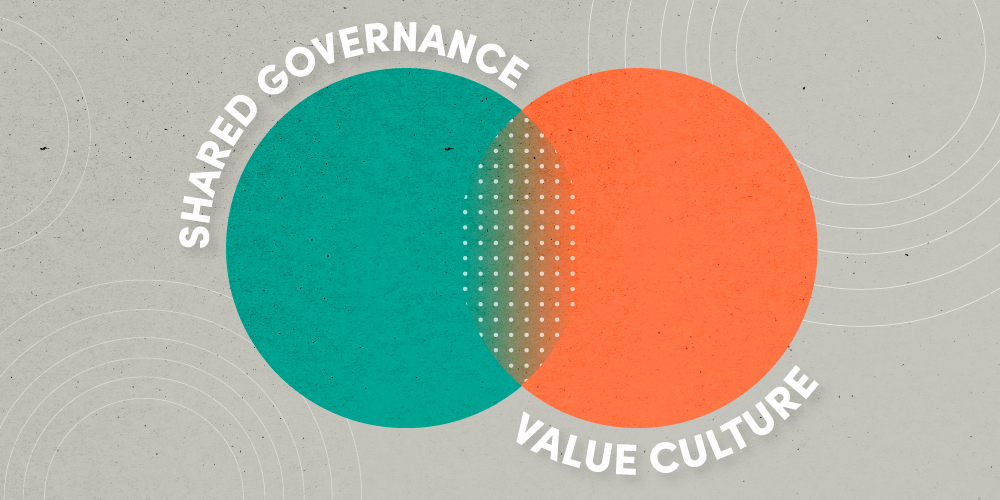niversity of Utah Health Hospitals and Clinics is dedicated to cultivating a culture of excellence across the organization. We are leveraging the ANCC Magnet model to steer our efforts in merging both new and existing structures and processes. This initiative aims to mold a culture where our team members not only thrive but also practice at the top of their profession.
Empowerment is improvement
As an improvement focused organization, we utilize Shared Governance and Value Culture to support improvement efforts through one common goal: empowering our frontline teams. Both emphasize the voice of the frontline and sharing in the responsibility and accountability of decision-making. They each empower, encourage and engage staff, which in turn, leads to improved outcomes.
Partners in Practice
Shared Governance is a pillar of the ANCC Magnet culture. It is a nursing professional practice model that supports shared decision-making at the local level. Teams in the Department of Nursing have a professional responsibility to participate.
Value Culture is an improvement methodology that enables teams to incorporate scientific thinking into our daily practice—it teaches us how to identify root causes to solve problems sustainably, test improvement methods and outcomes, and improve our processes through data informed decision-making.
Both Shared Governance and Value Culture use visual management tools (e.g., Team or Idea Boards) to make problems visible, bring teams together to prioritize work, and employ improvement methodologies to help solve problems.
As an organization, we’re not choosing to practice one over the other—Shared Governance and Value Culture complement one another, and we can leverage both to achieve desired outcomes.
Where Shared Governance and Value Culture align:
- Continuous improvement cultural transformation
- Promote empowerment, engagement, autonomy, mastery
- Make problems visible and enable those who face daily process problem to participate in solving them
- Promote equity, inclusivity and collaborative decision-making
- Provide a means to identify needs and provide leadership advocacy, support, and allocation of resources
- Provide a means to provide information/updates back to frontline staff
- Empowerment leads to increased staff engagement, satisfaction, and retention
- A thriving workforce, faster problem-solving, higher quality patient care
- Become the employer of choice
- Developing staff problem-solving skills is a top priority
- Expertise of staff is recognized and valued
- Curiosity, active listening
- Supportive coaching vs. directive
- Post sticky notes or PINS (problems, ideas, needs, suggestions) on a team board
- Collaborative prioritization and decision-making
- Staff empowered to solve frontline problems and advance problems as needed
- Local problem-solving and decision-making is the default, whenever feasible. Problems and decisions requiring expertise, authority, resources, or advocacy unavailable locally are advanced elsewhere in the system.
How Value Culture fits into our Shared Governance framework:Solving problems at the local level in real time: When we identify L1 PINS, we think about how to resolve issues locally without having to engage in a complex process. When encountering L2 PINS in Shared Governance, we use PDSA methodology to test change. Progressing Complex PINS: Our Shared Governance structure is designed to ensure our teams have a place to advance complex PINS, and our teams can utilize available resources to determine the complexity of the problem. Identifying and Implementing Improvement Measures: When we come across more complex situations like L3 or L4 PINS, Value Culture helps us identify the root cause of a problem, test new methods, and make the best data informed decision to solve the problem. |
U of U Health Value Engineering (contact: Steve Johnson) and System Quality (contact: Dane Falkner) improvement experts are here to help Shared Governance be successful. Because of their well-established relationships across our health system, they can be a liaison between departments, service lines, and units, and provide our teams with support, advocacy, and resources when they encounter higher level PINS. Their expertise in PDSA methodology can be leveraged through coaching opportunities for Shared Governance Team and Mentor Councils to develop an army of problem solvers and provide our teams with the knowledge and resources to feel truly empowered to drive change.
Mary-Jean (Gigi) Austria
Dane Falkner
Health systems across the nation utilize shared governance programs to empower teams to make decisions impacting their practice and area of work, increase accountability and autonomy, and improve quality of patient care. The U of U Health Department of Nursing offers its model, along with tips, to assist any team in implementing shared decision-making in their respective areas.
Magnet Program Director Mary-Jean (Gigi) Austria explains how Nursing Shared Governance provides support for knowledge sharing, clinical skill building, and collaborative decision-making closest to the point of care.
As teams across the UUHC Department of Nursing work to implement shared governance in their areas, we’re learning about team experiences and the impact shared governance has had so far. This month, Brenda Baker from Radiation Oncology shares how her team leveraged shared governance to break down workflow barriers.
